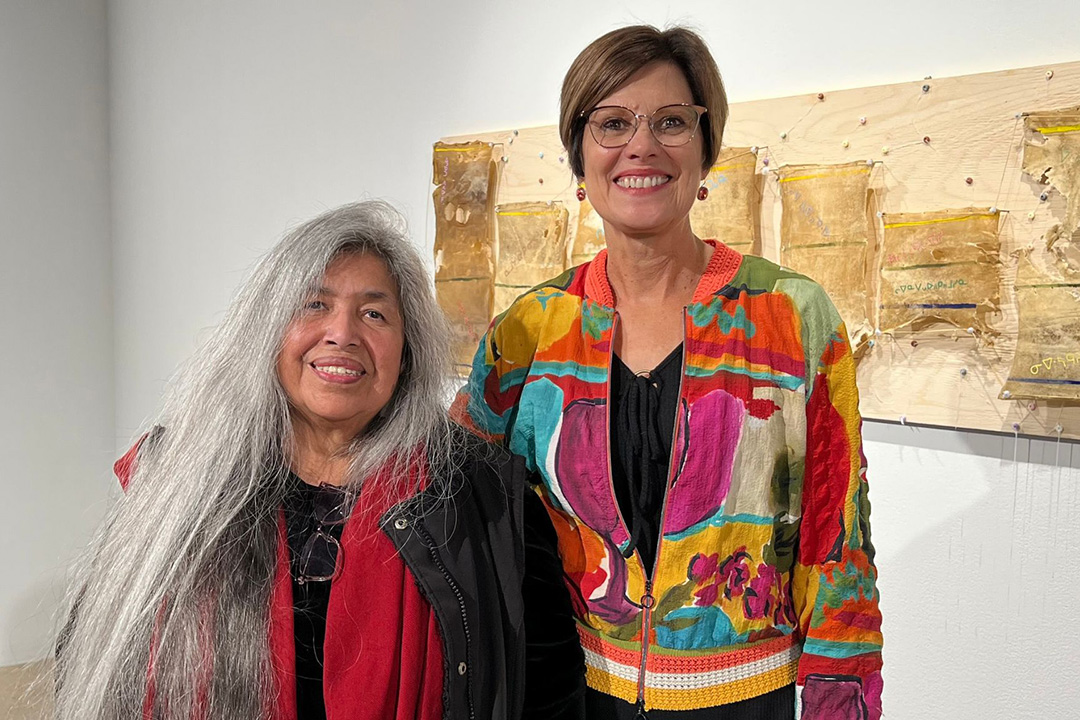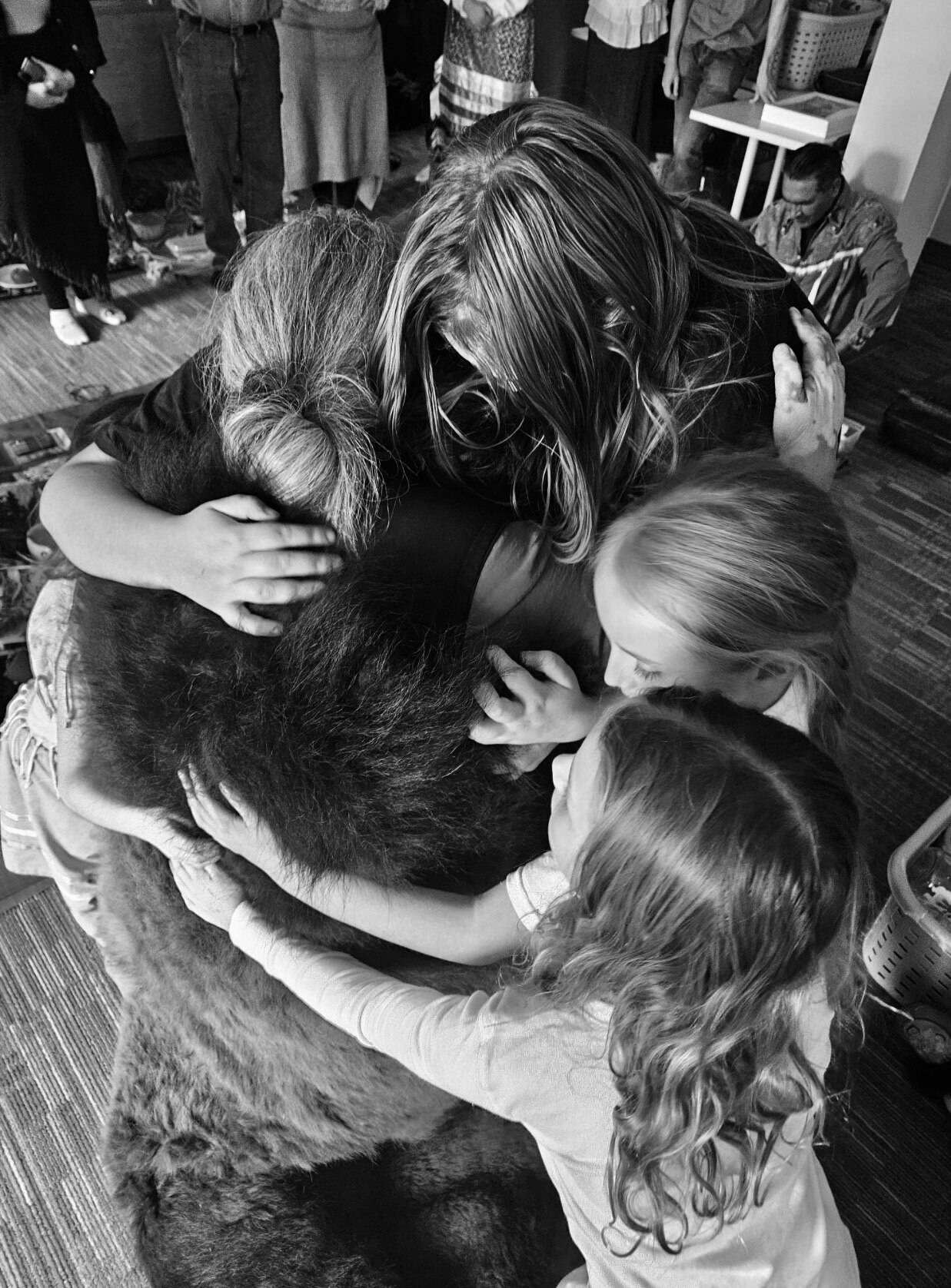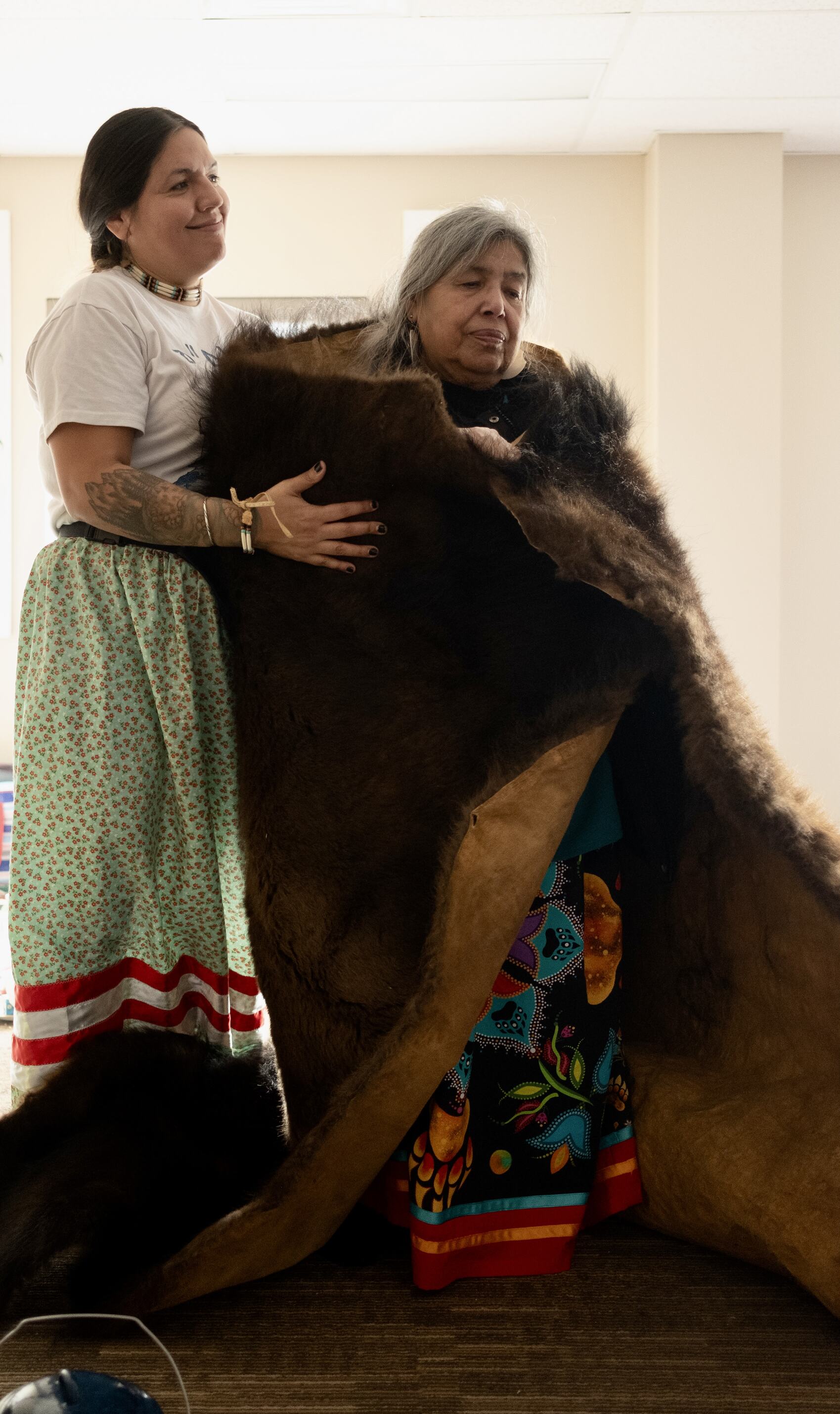
An urban elder’s journey: The role of tradition, community, and education
In October of 2023, Dr. Linda Young (BA’94, BFA’98, MEd’20, PhD'2023) earned her doctorate not through a traditional defence, but through Conversation. Her innovative dissertation format, comprised of 10 videos, four bookworks, a glossary of terms, and a gallery show, was developed through carefully followed traditional protocol, a connection to community, and a lifelong relationship with education.
By Kassidy Guy
Young is paskwaw-nehiyaw/Plains Cree from Onion Lake Cree Nation, Treaty 6 Territory. While growing up, Young absorbed traditional knowledge the way many Indigenous children do: by watching.
“I grew up memorizing,” said Young, “That’s how I learned, by watching what people did. I would learn about different things from my uncle, my great-grandfather, my aunties, my great-grandmother. Education has always been part of my life, but it wasn’t just Western education.”
In 1956, Young was taken to attend Saint Anthony’s Roman Catholic Indian Residential School in Onion Lake, where she spent 10 months of the year from the ages of five to 15. Adjusting to residential school was difficult, and Young found comfort in little things. Stories, in particular, reminded her of home and family.
“My great grandfather was a storyteller, so when we were at home, we knew he was going to share a story when he took his drum from the wall and start singing. So, [at residential school] I was excited when the Sister would come out, sit on a chair, and tell a story from a book. I didn’t understand the language, but the fact that she was telling a story was so amazing to me, and I loved it. It helped me adjust,” Young said.
Young remained in residential school until the age of 15. Pursuing high school was not possible at this time. Over the years, she continued her education through upgrading courses, specialized training, and brief forays into post-secondary education at the University of Regina and the University of Manitoba. In 1978, Young began her studies in the Indian Teacher Education Program (ITEP) at USask’s College of Education.
As she pursued higher education, Young was held back by her previous experiences with Western education in the residential school system.
“I never forgot my experience as a student in a residential school. Indian Residential Schools didn’t prepare us academically to be at a competitive pace with the other students, usually non-Indigenous students,” said Young, “In residential school, we grew up with the messaging that implied we were unteachable and that notion of not being as good as [non-Indigenous students] or as intelligent as [non-Indigenous students], well, you never get over it.”
Feeling discouraged, Young took some time away from her courses for self-discovery. Soon, she discovered a love for art, inspiring her to shift her focus from pursuing education to fine arts.
“It was really mind-opening for me because that’s where I learned about critical thinking. We had to critique the work we were looking at, critique the materials used, and look for what’s missing. It showed me that I am creative and that I can create work that changes people and impacts them,” shared Young.

With her Bachelor of Fine Arts under her belt, Young was compelled to continue her studies and explore pursuing her master’s degree. After hearing Dr. Debbie Pushor (PhD) from the College of Education speak at a conference, Young instantly connected with Pushor’s research. Later, Young asked Pushor to be her supervisor as she began the Master of Education program and worked to tell her story as a residential school survivor.
Young worked closely with Pushor as she navigated graduate studies and focused her research.
“The residential school story is my story, which is why I did it for my master’s program,” she said. “I wanted to talk about the stages of losing your culture, your language, your family, and what’s required to get back on that track.”
As one of the few remaining residential school survivors, Young felt it was her responsibility to share her experiences and how the trauma had carried through to the rest of her life.
This responsibility motivated Young to pursue her PhD through the College of Education following her master’s program, focusing on the role Elders play in reparation and reconciliation.
“A PhD is considered a very respected degree, and I feel like if it’s respected, then people will access that knowledge. Not because it’s me, but because it’s the university. That’s why I pursued a PhD, to have it accessible for the people who need it,” said Young.
“One of the questions that was asked of me was, why did I need to do a dissertation? I knew it would be hard, emotionally, mentally, and physically, similar to what I went through during my master’s. But we (Indigenous students and Survivors) choose to make the sacrifices required to get the work out there,” said Young.
Despite battling physical and mental challenges related to post-traumatic stress and intergenerational trauma, Young was determined to complete her PhD.
When asked what pushed her through the hardest days, Young gives credit to traditional protocol that she practiced throughout her studies.
“I would not have been able to do the work that I was doing with my dissertation if I didn’t [follow protocol] from start to finish,” said Young.

Following protocol refers to gifting tobacco to elders in exchange for knowledge, songs, stories, and prayer. The practice of gift giving is a centuries-old tradition for most Indigenous communities that expresses gratitude for the knowledge shared by kehtê-aya/Elders.
“When I started this PhD journey, I offered protocol (tobacco and cloth) and asked the Elders to offer prayers on my behalf so I could do this work,” explained Young. “I asked for prayers to help me complete my commitment, and that’s what got me through.”
While developing her PhD and research plan, Young knew that the conventional approach to a dissertation defence wouldn’t suit her approach to the project.
“I wanted it to be a Conversation, not a defence, because in Cree language, defence is a position you take to fight back, and I didn’t want that. I felt everybody in the Circle had something to share. The Sharing Circle format made it easier for me to process the questions and the sharing that each person did. I wanted to be in community. I wanted the artwork to be in the community, so I took it out of the institution, and anyone could come.”
Young and Pushor proposed a plan to the College of Graduate and Postdoctoral Studies (CGPS) to ensure that the college and her committee could accommodate Young’s unique approach to her dissertation.
“We contacted (Dean) Debby Burshtyn, and (former Associate Dean) Ryan Walker and asked if we could meet with them and propose this process for Linda,” said Pushor, “[Linda and I] don’t think we would have been able to do it without them. They made all the difference to us in terms of understanding the intention and what Indigenizing actually meant, what it looked like. They were integral.”
Young’s PhD dissertation included 10 videos, four bookworks, a glossary of terms, and a gallery show. The videos, organized into four distinct conversations with Elders from various communities, explored concepts such as the changing role of Elders, cultural trauma, reparations, and lived reconciliation in schools. Each Conversation was connected to and inspired by an original art piece Young created, using a variety of artistic mediums to tell a story.
Young’s novel approach to presenting and ‘defending’ her dissertation marks an essential milestone as USask and CGPS work to decolonize and Indigenize the university, but more work must be done.
“It’s not about bringing Indigenous ways into the structure we have now,” explained Pushor. “It’s dismantling this structure, and really assuming and working with Indigenous principles that they’ve lived by their whole history.”
Young hopes her story and the lessons she’s learned inspires other Indigenous scholars as they pursue higher education at USask.
“You have to have people you can trust. You need allies, you need people who support you, who believe in you,” said Young. “Don’t work in isolation. You don’t have all the knowledge; you have to work with people and accept the knowledge that is gifted to them. I think that’s a very community-minded way of doing things.”
Linda Young's doctorate degree will be confered at the June 2024 convocation ceremony.
Linda Young's dissertation materials are intended to serve as an accessible educational resource for all ages.
You can access videos and learn from her thesis, The Journey of a kêhtê-aya (elder): kiskisi sôhkisiwin, tâpôkêyimoh, sôhkitêhê, nâkatohkê: Memorize the Strength, Have Faith, Have a Strong Heart, Pay Attention, through the HARVEST repository.
Together, we will work towards Truth and Reconciliation. We invite you to join by supporting Indigenous achievement at USask.
Article re-posted on .
View original article.

